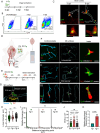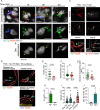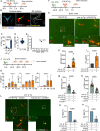ICAM-1/CD18-mediated sequestration of parasitized phagocytes in cortical capillaries promotes neuronal colonization by Toxoplasma gondii
- PMID: 40229286
- PMCID: PMC11997185
- DOI: 10.1038/s41467-025-58655-z
ICAM-1/CD18-mediated sequestration of parasitized phagocytes in cortical capillaries promotes neuronal colonization by Toxoplasma gondii
Abstract
Microbial translocation across the blood-brain barrier (BBB) is a prerequisite for colonization of the central nervous system. The obligate intracellular parasite Toxoplasma gondii chronically infects the brain parenchyma of humans and animals, in a remarkably stealthy fashion. We investigated the mechanisms of BBB traversal by T. gondii (genotypes I, II, III) and T. gondii-infected leukocytes, using intracarotid arterial delivery into the cerebral circulation of mice. Unexpectedly, parasitized dendritic cells (DCs) and other peripheral blood mononuclear cells were found to persistently sequester within cortical capillaries. Post-replicative egress of T. gondii from sequestered DCs was followed by rapid parasite localization within cortical neurons. Infection-induced microvascular inflammation dramatically elevated the sequestration of parasitized DCs, while treatments targeting the ICAM-1/CD18 leukocyte adhesion axis with blocking antibodies strongly reverted sequestration. The parasite effectors TgWIP and GRA15, known to promote leukocyte hypermigration and inflammatory activation, further increased both the capillary sequestration of infected DCs and cerebral parasite loads in a strain-dependent manner. These findings reveal that the sequestration of parasitized leukocytes in cortical capillaries, with subsequent BBB traversal following parasite egress, provides a mechanism for T. gondii's rapid access to cortical neurons during primary infection.
© 2025. The Author(s).
Conflict of interest statement
Competing interests: The authors declare that no competing interests exist.
Figures






Similar articles
-
Blood-brain barrier-restricted translocation of Toxoplasma gondii from cortical capillaries.Elife. 2021 Dec 8;10:e69182. doi: 10.7554/eLife.69182. Elife. 2021. PMID: 34877929 Free PMC article.
-
Toxoplasma effector-induced ICAM-1 expression by infected dendritic cells potentiates transmigration across polarised endothelium.Front Immunol. 2022 Aug 3;13:950914. doi: 10.3389/fimmu.2022.950914. eCollection 2022. Front Immunol. 2022. PMID: 35990682 Free PMC article.
-
The unicellular eukaryotic parasite Toxoplasma gondii hijacks the migration machinery of mononuclear phagocytes to promote its dissemination.Biol Cell. 2020 Sep;112(9):239-250. doi: 10.1111/boc.202000005. Epub 2020 May 19. Biol Cell. 2020. PMID: 32359185 Review.
-
Integrin-dependent migratory switches regulate the translocation of Toxoplasma-infected dendritic cells across brain endothelial monolayers.Cell Mol Life Sci. 2021 Jun;78(12):5197-5212. doi: 10.1007/s00018-021-03858-y. Epub 2021 May 22. Cell Mol Life Sci. 2021. PMID: 34023934 Free PMC article.
-
Early passage of Toxoplasma gondii across the blood-brain barrier.Trends Parasitol. 2022 Jun;38(6):450-461. doi: 10.1016/j.pt.2022.02.003. Epub 2022 Feb 25. Trends Parasitol. 2022. PMID: 35227615 Review.
Cited by
-
Comprehensive analysis of Toxoplasma gondii migration routes and tissue dissemination in the host.PLoS Negl Trop Dis. 2025 Jul 31;19(7):e0013369. doi: 10.1371/journal.pntd.0013369. eCollection 2025 Jul. PLoS Negl Trop Dis. 2025. PMID: 40743275 Free PMC article. Review.
References
-
- Abbott, N. J., Ronnback, L. & Hansson, E. Astrocyte-endothelial interactions at the blood-brain barrier. Nat. Rev. Neurosci.7, 41–53 (2006). - PubMed
-
- Coureuil, M., Lecuyer, H., Bourdoulous, S. & Nassif, X. A journey into the brain: insight into how bacterial pathogens cross blood-brain barriers. Nat. Rev. Microbiol15, 149–159 (2017). - PubMed
MeSH terms
Substances
Grants and funding
LinkOut - more resources
Full Text Sources

